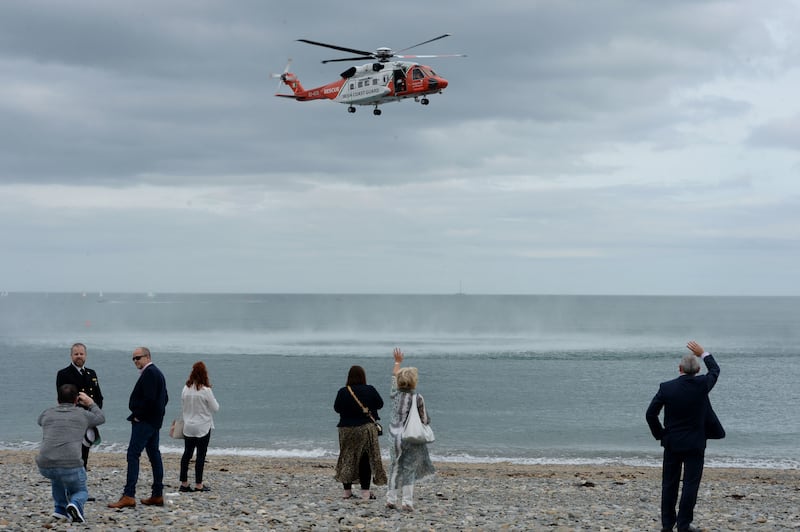Watch officer Colm Murphy was on duty in the Irish Coast Guard’s Dublin control room when a call came in at 8.33am last Wednesday.
The National Ambulance Service (NAS) was requesting immediate helicopter assistance following a road crash near Kells, Co Meath. The situation was urgent as a patient, then still trapped in a vehicle, needed to get to hospital in the critical “life or death” period following a serious crash.
Murphy checked the location and then where the nearest helicopter was before passing the call over to Martin Whyte, the station officer. Whyte confirmed with helicopter operator CHC that Rescue 116, based at Dublin Airport, a 14-minute flight from Kells, was available and willing to scramble immediately. He contacted Met Éireann for a localised weather report for the helicopter crew and notified Dublin Airport’s Air Traffic Control unit of the imminent mission.
As Rescue 116 was taking off, Whyte was in contact with Howth Coast Guard, tasking them to Beaumont Hospital to assist in bringing the patient from the hospital landing site – “a field beside the hospital” – to the emergency department.
READ MORE

The decision to task Howth Coast Guard, one of 44 voluntary units across the country, was made in case paramedics determined the patient had severe head injuries. The paramedics at the scene reported this was not the case and Rescue 116 brought the patient to Dublin Airport, from where they were transferred, within what doctors call the “golden hour”, from crash site to hospital.
Unlike their counterparts in many countries, the Irish Coast Guard is not part of the Defence Forces. Its primary responsibilities are search and rescue, promoting a safe marine environment and monitoring pollution at sea.
As the State’s fourth “blue light” service (after the Garda, ambulance and fire services) the coast guard’s ability to travel quickly and cover inaccessible terrain makes it an invaluable support to the State’s other emergency operators.
This was highlighted by a recent incident in Dalkey, south Dublin. At about 11pm locals were surprised to see the lights of a helicopter as the coast guard came to the assist gardaí and NAS, which was operating alongside the fire brigade and the coast guard’s Dún Laoghaire and Greystones units.
“A faller in Dalkey Quarry has sustained injuries in a fall of about 20m from a cliff,” said Whyte. “The Dún Laoghaire unit was just down the road, the Greystones unit has a climbing team and the helicopter was able to survey the terrain very quickly and provide light for the ground crews.”
The Irish Coast Guard manages co-ordination and communications through its Dublin-based Marine Rescue Co-ordination Centre and a Marine Rescue Sub Centres at Malin Head in Co Donegal and Valentia in Co Kerry.
Ivan Longmore, divisional controller with the Irish Coast Guard, says the number of callouts rises in good weather and on bank holiday weekends, when people flock to hills and coasts. So far this year, the coast guard helicopters have been called out 469 times, 275 of them since May. He says the service was called to 2,815 incidents last year and saved 671 lives. It has saved some 336 lives to date this year, some 200 of these since May.
Longmore explains that the area covered by the service, the State’s “Exclusive Economic Zone”, extends 320km from the coast and covers some 450,000km sq. To manage this area, the service has helicopter bases at Dublin, Waterford, Shannon and Sligo.
On banks of screens in the control rooms in each centre, watch officers use an automatic identification systems to find and identify vessels. When a rescue helicopter has to travel to a vessel far from base, normal communications can be lost and “top cover” is requested from the Air Corps. This involves another aircraft being deployed to relay communications between the scene and operation co-ordinators on shore.
Kevin Whitney, head of operations at the Irish Coast Guard, says the service will later this year take delivery of a new fixed-wing aircraft, allowing the coast guard to provide its own top cover.
He says efficient communications with stricken vessels or those with injured crew are vital. Medical advisers based in a unit called Medico in Cork are patched through to vessels at sea and an assessment is made as to whether the injured crew member needs an immediate medical evacuation.
Under a 10-year contract awarded to Bristow Ireland Limited, the coast guard will have 24/7 access to two King Air fixed-wing aircraft, to be based at Shannon Airport. There will also be a fleet of six search and rescue configured AW189 helicopters located at the existing bases in Dublin, Shannon, Sligo and Waterford.
The new coast guard aviation service is understood to be worth more than €600 million. It will be introduced on a phased basis and is to be fully operational by next July.
The sea is, of course, where some of the most dramatic action happens. Keeping emergency VHF (very high frequency) radio channels open for vessels in distress is vital.
On Wednesday, watch officer Thomas Brennan was dealing with a VHF call from a French sailor off the Co Wexford coast, who was seeking a 24-hour weather forecast ahead of a potential voyage home.
Brennan was happy to direct him to a weather report, but asked the sailor to move from Channel 16, which is meant to be solely for emergency matters. Minutes later the sailor could be heard discussing the weather report with a friend, still on Channel 16, and Brennan had to interrupt the conversation to advise the sailor to move to another channel.
“This can be challenging. But if an emergency call is weak, we might not hear someone over that conversation,” he said.
- Sign up for push alerts and have the best news, analysis and comment delivered directly to your phone
- Join The Irish Times on WhatsApp and stay up to date
- Listen to our Inside Politics podcast for the best political chat and analysis









